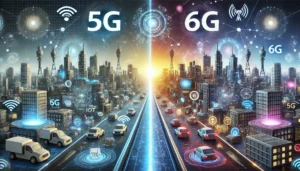Introduction
Wireless communication technology has evolved significantly over the years, from 1G to the current 5G networks, revolutionizing how we connect, work, and live. With 5G still in its expansion phase, researchers and industry leaders are already preparing for the next leap—6G. But how does 6G compare to 5G, and what can we expect from the future of wireless networks? This article explores the key differences, technological advancements, and the potential impact of 6G on various industries.
Understanding 5G Technology

5G, the fifth generation of wireless networks, was introduced to provide faster speeds, lower latency, and higher capacity than its predecessor, 4G LTE. Here are some key features of 5G:
- High Speed: 5G networks can achieve speeds of up to 10 Gbps, significantly faster than 4G LTE.
- Low Latency: With latency reduced to as low as 1 millisecond, 5G supports real-time applications such as cloud gaming, autonomous vehicles, and remote surgeries.
- Increased Connectivity: 5G can support up to one million devices per square kilometer, enabling massive IoT (Internet of Things) deployment.
- Improved Energy Efficiency: The network is designed to consume less power, improving battery life for connected devices.
While 5G is already transforming industries such as healthcare, manufacturing, and entertainment, researchers are now looking ahead to the future—6G.
What is 6G and How Will It Be Different?
6G is expected to be the sixth generation of wireless networks, anticipated to launch around 2030. While it is still in the research and development phase, experts predict that 6G will far surpass 5G in speed, capacity, and efficiency. Here are the major advancements expected in 6G technology:
- Ultra-High Speeds: 6G is projected to offer speeds up to 100 Gbps or even 1 Tbps, making downloads and streaming almost instantaneous.
- Sub-Millisecond Latency: Latency is expected to drop to sub-millisecond levels, enabling seamless real-time applications, including advanced augmented reality (AR) and virtual reality (VR).
- Integration with AI and Machine Learning: AI-driven network optimization will enhance efficiency, predict network congestion, and provide adaptive services.
- Terahertz (THz) Frequency Spectrum: 6G will likely operate in the terahertz frequency range (0.1 THz to 10 THz), providing much higher data transmission rates than the millimeter-wave spectrum used in 5G.
- Holographic Communication: Future networks may support holographic calls, revolutionizing video conferencing and social interactions.
- Enhanced IoT and Smart Cities: 6G will improve the performance of interconnected smart devices, paving the way for fully autonomous smart cities.
Key Differences Between 5G and 6G
| Feature | 5G | 6G (Expected) |
|---|---|---|
| Speed | Up to 10 Gbps | 100 Gbps to 1 Tbps |
| Latency | ~1 millisecond | Sub-millisecond |
| Frequency | Up to 100 GHz | Terahertz (THz) range |
| Connectivity | 1 million devices/km² | 10 million devices/km² |
| Applications | IoT, AR, VR, automation | AI-driven services, smart cities, holography |
Potential Applications of 6G Technology
The arrival of 6G will unlock new possibilities in various industries:
- Healthcare: Remote surgeries, AI-assisted diagnostics, and real-time patient monitoring with zero lag.
- Transportation: Fully autonomous vehicles with high-speed V2X (vehicle-to-everything) communication.
- Education: Holographic classrooms and AI-powered personalized learning experiences.
- Entertainment: Ultra-high-resolution VR gaming and immersive media experiences.
- Industrial Automation: Smart factories with AI-powered robotics working in sync through real-time connectivity.
- Space Communication: 6G could extend connectivity beyond Earth, supporting space exploration and satellite-based internet.
Challenges and Considerations
Despite its promising future, 6G faces several challenges:
- Infrastructure Development: Building a global 6G network will require new infrastructure, increasing deployment costs.
- Energy Consumption: Terahertz frequencies may lead to higher power consumption, requiring innovative energy-efficient solutions.
- Security Risks: More connected devices mean increased cybersecurity threats, necessitating robust security frameworks.
- Regulatory Issues: Governments will need to allocate and regulate the THz spectrum for 6G applications.
The Road Ahead
While 5G is still being rolled out worldwide, researchers are laying the groundwork for 6G. Industry giants like Nokia, Ericsson, and Huawei, along with governments and universities, are investing in 6G research. Standardization efforts and pilot programs will play a crucial role in shaping the next generation of wireless technology.
Conclusion
The transition from 5G to 6G represents a monumental leap in wireless communication, promising ultra-fast speeds, minimal latency, and AI-driven networks. While 5G is revolutionizing industries today, 6G will push the boundaries of connectivity, enabling futuristic applications like holographic communication and fully autonomous systems. Although challenges remain, the development of 6G is inevitable, and by 2030, we may experience a world more connected than ever before.
——————- More Links ————————
3.https://socialevity.com/story20711613/best-ipl-2025-trading-strategies-for-playingexchange-users
6.https://throbsocial.com/story20776219/join-lotus-id-cricket-for-exciting-ipl-gaming-predictions
8.https://owntweet.com/thread/255882
9. https://socialrator.com/story9547017/mahadev-book-id-for-ipl-lovers-get-started-today
12. https://nimmansocial.com/story8683370/gold-365-get-the-best-ipl-cricket-match-predictions